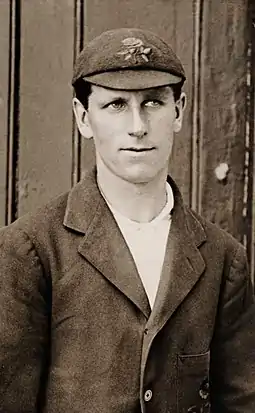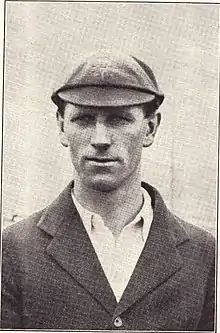Ernest Tyldesley
George Ernest Tyldesley (5 February 1889 – 5 May 1962) was an English cricketer. The younger brother of Johnny Tyldesley and the leading batsman for Lancashire. He remains Lancashire's most prolific run-getter of all time. Tyldesley went on the 1928/29 Ashes Tour, where he played in one test, and played only four times in a home Ashes Test, but in 1921 he did very well in the last two games, scoring 78 at Old Trafford.
 Tyldesley in about 1925 | ||||||||||||||||||||||||||||||||||||||||
| Personal information | ||||||||||||||||||||||||||||||||||||||||
|---|---|---|---|---|---|---|---|---|---|---|---|---|---|---|---|---|---|---|---|---|---|---|---|---|---|---|---|---|---|---|---|---|---|---|---|---|---|---|---|---|
| Born | 5 February 1889 Worsley, Lancashire | |||||||||||||||||||||||||||||||||||||||
| Died | 5 May 1962 (aged 73) Rhos-on-Sea, Denbighshire, Wales | |||||||||||||||||||||||||||||||||||||||
| Batting | Right-handed | |||||||||||||||||||||||||||||||||||||||
| Bowling | Right-arm slow-medium | |||||||||||||||||||||||||||||||||||||||
| International information | ||||||||||||||||||||||||||||||||||||||||
| National side | ||||||||||||||||||||||||||||||||||||||||
| Test debut | 28 May 1921 v Australia | |||||||||||||||||||||||||||||||||||||||
| Last Test | 16 March 1929 v Australia | |||||||||||||||||||||||||||||||||||||||
| Career statistics | ||||||||||||||||||||||||||||||||||||||||
| ||||||||||||||||||||||||||||||||||||||||
Source: CricketArchive, 25 May 2019 | ||||||||||||||||||||||||||||||||||||||||
Career
Tyldesley was born in Roe Green, Worsley, Lancashire. He had a slow start in county cricket in 1909, and though he played fairly regularly for Lancashire in the following three years – scoring his first century against Sussex in 1912 – but it was 1913 before he was firmly established in the team. That season he reached 1,000 runs for the first time and in 1914, the last season before war put a stop to cricket, he maintained this form.
After war ended, 1919 saw Tyldesley jump into the ranks of the top English batsmen with some solid batting, which resulted in his nomination as a Cricketer of the Year by Wisden. Though 1920 was uneven despite a score of 244 against Warwickshire, Tyldesley was already among a large crop of top-class professional batsmen.

1921 saw Tyldesley make his debut in Test cricket; though he was dropped after a poor performance on a damp pitch at Trent Bridge. 1922 saw him reach 2,000 runs for the first time. Tyldesley continued until injury kept him out of the last half of 1925. 1926, however, saw Tyldesley scoring 50 or better in 10 consecutive innings.
Tyldesley maintained his form in 1927, and scored 3,024 runs in 1928. However, he was not at his best on his only tour of Australia in 1928/29 until injury weakened England's team at the end of the tour.
Though never selected for the Test team again Tyldesley remained a prolific scorer for Lancashire right up to 1934, and in 1933 had the distinction of being granted a second benefit for his services to the county, though this only raised £802 as against £2,458 for his 1924 benefit. He scored his 100th first-class century in a game against Northamptonshire in July 1934.[1] 1935, at the age of 46, saw him again affected by injury and playing only rarely – while the following year, playing as an amateur, he only played two matches before moving into business.
Upon his finally appearance in Tests in 1929, Tyldesley's batting average of 55.00 was the highest of any player, at that time, to have completed a career of 20 innings or more.
Name
Tyldesley was called 'George' at home, his given first name. However he signed autographs Ernest.[2]
Death and legacy
Tyldesley died in 1962 in Rhos-on-Sea, Denbighshire, Wales, where he lived for several years.
Tyldesley's elder brother JT named the family home in Worsley, Lancashire, "Aigburth" to commemorate his younger brother's Lancashire debut at the Liverpool ground where Lancashire County Cricket Club occasionally play their matches. The home still stands today and a plaque telling the story has been erected by the Worsley Heritage Walks.
His great-great-nephew is the Yorkshire and England cricketer Michael Vaughan.[3]
References
- "Tyldesley's 100th Century". The Indian Express. 9 July 1934. Retrieved 8 May 2017.
- Cricket Matches 1934 Jim Ledbetter (Limlow Books) p.121
- Holburn, Graham. Ernest Tyldesley: illuminated the golden age of cricket
External links
 Media related to Ernest Tyldesley at Wikimedia Commons
Media related to Ernest Tyldesley at Wikimedia Commons- Ernest Tyldesley at ESPNcricinfo